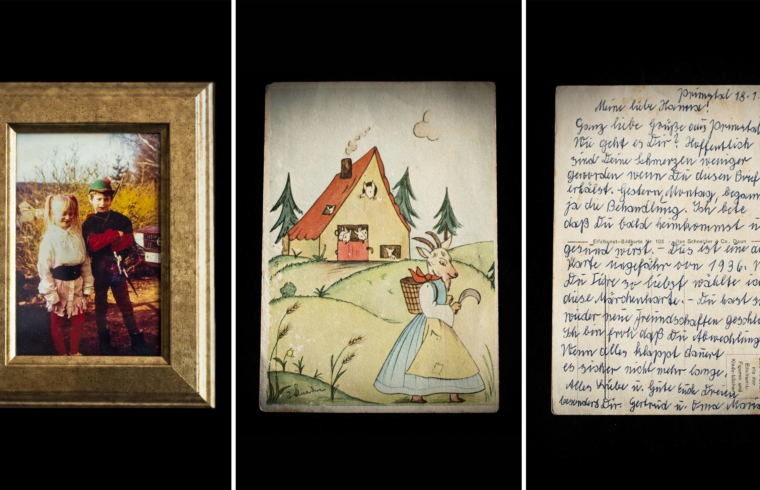Lesen Sie diesen Text auf Deutsch
It’s like someone is pounding on Nele’s
knee with a hammer as hard as they can, over and over again. “It’s a dull
pain,” she says, unsure whether “dull” is the right word.
It is a feeling she has known for 26 years.
It’s with her every hour, every minute. On bad days, it can feel like a
bulldozer is driving over her legs. Sometimes, it’s like someone is stabbing
her knees with a knife. At others, like a flamethrower is being aimed at her
joints. These are the images Nele has come up with to describe to doctors what
is wrong with her.
It was the summer of 1992, the air outside
smelled like sunblock and raspberry bushes. Nele was seven years old, and like
she did so often that year, she headed out with her friends to clamber around
in the forest. There was this one boulder that had roots coming off it like
bristly hairs you could grab onto. It was no bigger than 4 meters (13 feet),
but you needed skill and stamina to make it all the way to the top. Nele was
one of the best at it. When the tiny girl proudly stood on top, watching the
others as they climbed, her blond ponytail would bob jauntily in the wind. Almost
every day, she came home with ticks, often 10 or 15. Her mother would pull them
out with tweezers, and she had so much experience doing so that men from the
neighborhood would sometimes come by when one of the parasites had burrowed
into their skin. But that was the last day she would pull out ticks. She would no longer be able do so.
“Only a Children’s Flu”
It started with a headache and then came
the fever. The family doctor sent the girl home. “It’s only a children’s
flu,” he said, creasing his brow. But the headaches grew worse and the
fever got higher. The doctor’s creases deepened into furrows. Nele didn’t cry.
She wanted to be a brave girl, as she had learned from her big family and
churlish cousins. But when she began showing signs of localized paralysis, her
mother took her to a clinic. The staff there had no experience with symptoms
like Nele’s, so her files were sent to specialists in the United States who
diagnosed it as Lyme disease.
The odds of contracting Lyme disease are
not altogether low. According to the Robert Koch Institute (RKI), a German
government agency responsible for disease control and prevention, up to 30
percent of ticks in some parts of Germany carry the pathogens that cause the
disease. Starting in early summer, they multiply, especially in Germany’s south
and southwest, preferring to live in the tall grasses on the edges of forests. Studies
show that between 80,000 and 200,000 people are infected with the borrelia
bacteria every year. They can attack various organ systems, and usually take
aim at the skin, the nervous system and joints. Those infected suffer from
fatigue, muscle and joint pain, and swollen lymph nodes. It feels like the beginnings
of a bad flu. But, unlike the flu, there is no vaccination against Lyme
disease, and sometimes no cure. Symptoms include in rare cases paralysis or arthritic pain that can move to different parts of the body and persist for years.
Like Flames on a Wall
These days, treatments for the disease have
an increasing success rate, but that wasn’t the case in 1992. Nele’s parents bought
a binder for their daughter’s medical files, but it soon filled up and they had
to get another. In the hospital, the seven-year-old was treated with
antibiotics, which seemed to help. But a few weeks later, the pain arrived and never
went away. She had pangs in her legs and they would grow stiff, and then the
sensation would shoot up her body to her hips – fast, overpowering and scary,
like flames up a wall. The burning, hammering and stabbing, as Nele describes
it, were so intense she became nauseated. When she squatted down, she often
needed help getting back up. Eventually, Nele had trouble walking. The borrelia
bacteria were still inside her, but this time, they had attacked her joints
instead of her nervous system. Again, she was treated with antibiotics and her results of the blood tests normalized. But although Nele was healthy on paper, the pain
remained. Like mites in a mattress, it had infested her limbs. The doctors
didn’t know what to do.
Nele’s father drove with her across
Germany. GPS navigation didn’t yet exist, so his daughter had to learn how to
read maps. There was a thick blue road atlas in the glove box and it became a
constant companion. Nele would later know the maps of some regions like the
back of her hand. When she was in the hospital, her grandmother would send her “letters,”
as she called the old-fashioned, prewar postcards that were decorated with
images of wandering goats or sledding children. “Hopefully your pain has
gotten better by the time you receive this letter,” the grandmother wrote
in the mid-1990s. “I am praying that you will soon come home healthy.”
Nele loved the cards. She has kept some of them to this day, even though her
grandmother’s prayers didn’t help.
© Lena Mucha für ZEIT ONLINE
In the years that followed, Nele was
treated with antibiotics, with cortisone, with opiates, with autologous blood
transfusions. Her arms became so riddled that on some days, the doctors were
unable to find a vein to take her blood or give her an IV. Her parents tried
every therapy conventional medicine had to offer, and when that didn’t help,
all alternative therapies as well. One homeopath wanted to pull
Nele’s teeth. She was told to swing a pendulum over her food to distinguish good apples from bad apples. She got insoles for her shoes. A couple of self-proclaimed
healers laid hands on her. Another suggested a vegan diet: “Then everything
will be OK again” he said – and seemed like he was trying to convince
himself more than anything. Even Dr. Müller-Wohlfahrt, the famous team doctor for
FC Bayern Munich, sent her home. There was, after all, nothing left to
diagnose.
Hits: 377





















